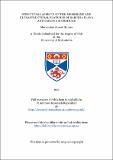Files in this item
Structural aspects of the membrane and ultrastructural features of sarcina flava and sarcina morrhuae
Item metadata
| dc.contributor.advisor | Thirkell, David | |
| dc.contributor.author | Hunter, Marcus Ian Stuart | |
| dc.coverage.spatial | 154 p., 44 p. of plates. | en_US |
| dc.date.accessioned | 2018-06-14T08:28:07Z | |
| dc.date.available | 2018-06-14T08:28:07Z | |
| dc.date.issued | 1971 | |
| dc.identifier.uri | https://hdl.handle.net/10023/14035 | |
| dc.description.abstract | 1. The preparation, purification and properties of a water-soluble membrane component from S. flava using the synthetic detergent Lubrol L has been described. This fraction contained carotenoid, glucose and peptide, was highly stable to heat and pH extremes, and release of free carotenoid from it proved extremely difficult. The possible effect of the binding of the membrane components within detergent micelles is discussed and the dangers inherent, in the determination of molecular weights, by osmometry or ultracentrifugation, in the presence of detergent have been indicated. 2. The polar carotenoid subfractions from S. flava have been characterised and found to consist of carotenoid, glucose and peptide. The linkage between carotonoid and glucose is presumed to be glycosidic, and a model for the in vivo orientation of the carotenoid complex in the bacterial membrane has been proposed. A possible correlation between membrane stability and carotenoid content has been found, and this is discussed in relation to the model. 3. After complete removal of the free pigments from S. morrhuae by solvent extraction, a water soluble carotenoid fraction was isolated and characterised. The material, whose molecular weight is approximately 9,000 contains carotenoid, glucose and peptide. The bond between glucose and carotenoid is again presumed to be glycosidlc, and the peptide moiety contains high proportions of the acidic amino acids, the significance of which is discussed. This bound pigment is also thought to represent one form in which: carotenoid is bound in the bacterial membrane. 4. The effect of the age of the culture on the chemical composition of the total membrane fraction from S. flava has been investigated. Both protein and lipid contents decrease with age although there is little variation in carbohydrate content. It is suggested that the decreased lipid content is a reflection of the increased binding of lipid to protein with age. Considerable variation in the fatty acid composition with age was observed, which makes the use of the fatty acid profile as a taxonomic criterion for this species of doubtful value. The presence of a sterol in S. flava membrane lipids is indicated although from GLC data, it seems unlikely that this is cholesterol. Mono-saccharides detected in membrane hydrolysates were ribose, rhamnose, glucose, and mannose. The presence of glucosamine and galactosamine was also indicated. 5, The general ultrastructural features of whole cells of both S. flava and S. morrhuae have been described. S. flava exhibits many of the fine structural features common to Gram-positive organisms and was seen to form the packets of cells typical of the Sarcinae. Cell division in S. flava was shown to be of the cell membrane septation type, and a mechanism for this mode of division has been proposed. Preparation of protoplasts from S. flava using the method of Baird-Parker and Woodroffe (1967) was unsuccessful, but the treatment with lysozyme, revealed a layered appearance of the cell wall. Several intracytoplasmic membranous inclusions were seen in these cells and their relationship to mesosomes is discussed. Mesosomes as such were also present, but never in association with developing septa. The effect of varying conditions of fixation on the fine structure of S. flava was also studied. Evidence has been presented that, under certain conditions, sporulation may occur in S. flava. Good fixation of S. morrhuae cells proved difficult to achieve, and this may be due to insufficient concentration of salts in the fixation medium. Cells of S. morrhuae are approximately twice the size of S. flava cells, and division was seen to occur in a much more random fashion, producing irregular clumps of cells with common cell walls. Spherical or ovoid bodies of unknown composition were seen in association with the cytoplasmic membrane. | en_US |
| dc.language.iso | en | en_US |
| dc.publisher | University of St Andrews | |
| dc.subject.lcc | QR83.S3H8 | |
| dc.subject.lcsh | Hydrogen bacteria | en |
| dc.title | Structural aspects of the membrane and ultrastructural features of sarcina flava and sarcina morrhuae | en_US |
| dc.type | Thesis | en_US |
| dc.type.qualificationlevel | Doctoral | en_US |
| dc.type.qualificationname | PhD Doctor of Philosophy | en_US |
| dc.publisher.institution | The University of St Andrews | en_US |
This item appears in the following Collection(s)
Items in the St Andrews Research Repository are protected by copyright, with all rights reserved, unless otherwise indicated.

